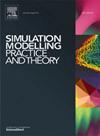利用机器学习和特征工程在无服务器计算中实现最佳数据驱动的扩展决策
IF 3.5
2区 计算机科学
Q2 COMPUTER SCIENCE, INTERDISCIPLINARY APPLICATIONS
引用次数: 0
摘要
无服务器计算提供了可伸缩性和成本效率,但平衡性能和成本仍然具有挑战性,特别是在可能导致冷启动或资源分配不当的扩展决策中。这项研究的动机是需要通过开发智能的、数据驱动的扩展决策来最大限度地减少冷启动的影响,并优化无服务器应用程序中的资源利用率。我们深入研究使用机器学习和特征工程来建模和模拟预测,以实现Azure功能应用程序(AFA)的最佳扩展决策。我们的重点在于预测配置或取消配置功能应用程序环境的理想时机。使用历史调用数据,我们应用滑动窗口将时间序列数据转换为分类为加载或卸载类的模式,考虑到不同的目标时期。为了确定最有效的模型,我们比较了有和没有校准的各种基线模型(等渗和s型)的性能,以提高精度。此外,我们评估了调用模式中的多种特征提取方法,并探索了使用主成分分析(PCA)进行降维以降低计算成本。使用最佳确定的配置,我们随着时间的推移建模和模拟类模式,以比较实际的类与预测的类,重点关注与冷启动相关的内存使用和成本。该模型在不同设置下使用各种指标进行了全面评估,揭示了通过应用校准和特征工程方法在缩放决策方面取得的显着改进。这些发现证明了机器学习在无服务器计算中智能、数据驱动的扩展决策方面的潜力,为云提供商优化资源分配和开发人员构建更高效、响应更快的无服务器应用程序提供了有价值的见解。具体而言,该方法可以集成到无服务器平台中,根据预测的工作负载需求自动调整资源配置,减少冷启动延迟,提高成本效益。本文章由计算机程序翻译,如有差异,请以英文原文为准。
Leveraging machine learning and feature engineering for optimal data-driven scaling decision in serverless computing
Serverless computing offers scalability and cost-efficiency, but balancing performance and cost remains challenging, particularly in scaling decisions that can lead to cold starts or resource misallocation. This research is motivated by the need to minimize the impact of cold starts and optimize resource utilization in serverless applications by developing intelligent, data-driven scaling decisions. We delve into using machine learning and feature engineering to model and simulate predictions for optimal scaling decisions for Azure Function Apps (AFA). Our focus lies in predicting the ideal timing for provisioning or de-provisioning the Function App’s environment. Using historical invocation data, we applied a sliding window to transform the time-series data into patterns categorized as load or unload classes, considering various target periods. To identify the most effective model, we compared the performance of various baseline models with and without calibration (isotonic and sigmoid) to enhance precision. In addition, we assess multiple feature extraction methods in invocation patterns and explore the use of Principal Component Analysis (PCA) for dimensionality reduction to reduce computation costs. Using the best-identified configurations, we model and simulate the class patterns over time to compare the actual classes with the predicted ones, focusing on memory usage and the costs associated with cold starts. The proposed model is thoroughly evaluated using various metrics under different setups, revealing notable improvements in scaling decisions achieved by applying calibration and feature engineering methods. These findings demonstrate the potential of machine learning for intelligent, data-driven scaling decisions in serverless computing, offering valuable insights for cloud providers to optimize resource allocation and for developers to build more efficient and responsive serverless applications. Specifically, the proposed method can be integrated into serverless platforms to automatically adjust resource provisioning based on predicted workload demands, reducing cold start latency and improving cost-effectiveness.
求助全文
通过发布文献求助,成功后即可免费获取论文全文。
去求助
来源期刊

Simulation Modelling Practice and Theory
工程技术-计算机:跨学科应用
CiteScore
9.80
自引率
4.80%
发文量
142
审稿时长
21 days
期刊介绍:
The journal Simulation Modelling Practice and Theory provides a forum for original, high-quality papers dealing with any aspect of systems simulation and modelling.
The journal aims at being a reference and a powerful tool to all those professionally active and/or interested in the methods and applications of simulation. Submitted papers will be peer reviewed and must significantly contribute to modelling and simulation in general or use modelling and simulation in application areas.
Paper submission is solicited on:
• theoretical aspects of modelling and simulation including formal modelling, model-checking, random number generators, sensitivity analysis, variance reduction techniques, experimental design, meta-modelling, methods and algorithms for validation and verification, selection and comparison procedures etc.;
• methodology and application of modelling and simulation in any area, including computer systems, networks, real-time and embedded systems, mobile and intelligent agents, manufacturing and transportation systems, management, engineering, biomedical engineering, economics, ecology and environment, education, transaction handling, etc.;
• simulation languages and environments including those, specific to distributed computing, grid computing, high performance computers or computer networks, etc.;
• distributed and real-time simulation, simulation interoperability;
• tools for high performance computing simulation, including dedicated architectures and parallel computing.
 求助内容:
求助内容: 应助结果提醒方式:
应助结果提醒方式:


